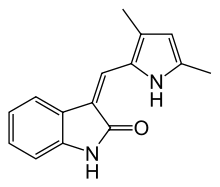All AbMole products are for research use only, cannot be used for human consumption.

SU5416 (Semaxanib) is a potent and selective vascular endothelial growth factor (VEGF) receptor protein tyrosine kinase 1/2 inhibitor that also inhibits other tyrosine kinases KIT, MET, FLT3 and RET. SU5416 inhibited cell migration of human vascular endothelial cells expressing both Flt-1 and KDR in response to VEGF and also inhibited the cell migration in response to placenta growth factor (PIGF), a specific ligand for Flt-1. Chemotaxis of monocytes expressing only Flt-1 was also inhibited by SU5416 in a dose-dependent manner. Moreover, SU5416 was found to inhibit tyrosine kinase of Flt-1 in response to PIGF in vitro. SU5416 efficiently inhibited Kit activity in vivo when administered on a twice-weekly schedule.
Another CAS# 194413-58-6
| Cell Experiment | |
|---|---|
| Cell lines | C6, Calu 6, A375, A431, and SF767T |
| Preparation method | Tumor Cell Lines and Growth Assays. The EPH4-VEGF cell line is a murine epithelial cell line engineered to overexpress murine VEGF. EPH4-VEGF cells were cultured in DMEM/F-12; C6 cells were cultured in Ham’s F-10 and A375, A431, and LNCAP cells in DMEM. All of these cultures were supplemented with 10% FBS and 2 mM L-glutamine. Calu 6 and SF767T cells were cultured in MEM supplemented with 10% FBS, 2 mM L-glutamine, 1 mM sodium pyruvate, and 0.1 mM MEM nonessential amino acids solution. C6, Calu 6, A375, A431, and SF767T were plated in their respective growth medium at 2 × 103 cells/100 μl/well in 96-well, flat-bottomed plates. SU5416 was serially diluted in media containing DMSO (<0.5%) and added to cultures of tumor cells 1 day after the initiation of culture. Cell growth was measured after 96 h using the sulforhodamine B method. IC50s were calculated by curve fitting using four-parameter analysis. |
| Concentrations | 0, 0.05, 0.5, 5, 50 µm |
| Incubation time | 96 h |
| Animal Experiment | |
|---|---|
| Animal models | Female BALB/c nu/nu mice Intracolonic Xenograft Model |
| Formulation | DMSO |
| Dosages | 25 mg/kg/day 50µl for 39 days |
| Administration | i.p. bolus injection |
| Molecular Weight | 238.28 |
| Formula | C15H14N2O |
| CAS Number | 204005-46-9 |
| Solubility (25°C) | DMSO 5 mg/mL DMF 20 mg/mL |
| Storage |
Powder -20°C 3 years ; 4°C 2 years In solvent -80°C 6 months ; -20°C 1 month |
| Related VEGFR/PDGFR Products |
|---|
| SU5208
SU5208 inhibits vascular endothelial growth factor receptor-2 (VEGFR2). |
| VEGFR-IN-1
VEGFR-IN-1 is a potent angiogenesis inhibitor with IC50s of 0.02, 0.18, 0.24 7.3, and 7 µM for KDR, Flt-1, c-Kit, EGF-R, and c-Src, respectively. |
| (Z)-Orantinib
(Z)-Orantinib ((Z)-SU6668) is a potent, selective, orally active and ATP competitive inhibitor of Flk‐1/KDR, PDGFRβ, and FGFR1, with IC50s of 2.1, 0.008, and 1.2 µM, respectively. |
| (Rac)-SAR131675
(Rac)-SAR131675 is the racemate of SAR131675. |
| AGL 2043
AGL 2043 is an effective inhibitor of PDGFR (IC50=0.8 μM) and TEL-PDGFR kinases, as well as FLT3 and KIT kinases. |
All AbMole products are for research use only, cannot be used for human consumption or veterinary use. We do not provide products or services to individuals. Please comply with the intended use and do not use AbMole products for any other purpose.


Products are for research use only. Not for human use. We do not sell to patients.
© Copyright 2010-2024 AbMole BioScience. All Rights Reserved.
